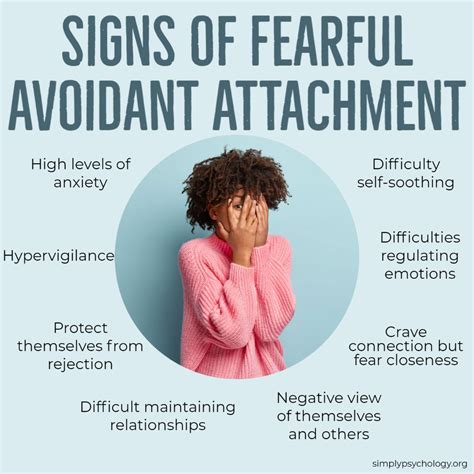How To Deal With Fearful Avoidant Attachment
Ronan Farrow
Mar 31, 2025 · 3 min read

Table of Contents
How to Deal with Fearful-Avoidant Attachment
Fearful-avoidant attachment, a complex and often painful attachment style, stems from a conflict between a deep desire for connection and an intense fear of intimacy. Understanding this internal conflict is the first step towards healing and building healthier relationships. This guide explores strategies to navigate the challenges of this attachment style and foster more secure connections.
Understanding Fearful-Avoidant Attachment
Fearful-avoidant attachment is characterized by a simultaneous yearning for closeness and a profound fear of rejection or abandonment. Individuals with this attachment style often experience intense emotional swings and contradictory behaviors. They may crave intimacy but simultaneously sabotage relationships through avoidance, pushing partners away before feeling vulnerable. This stems from early childhood experiences where inconsistent caregiving created a sense of insecurity and distrust.
The Roots of Fearful-Avoidant Attachment
- Inconsistent Caregiving: Unpredictable responses from caregivers during childhood can leave a lasting impact, creating a sense of uncertainty about the reliability of relationships.
- Trauma: Experiences of abuse, neglect, or significant loss can contribute to the development of fearful-avoidant attachment.
- Invalidation of Emotions: Children whose emotional expressions were dismissed or punished may learn to suppress their feelings, leading to difficulties expressing vulnerability in adult relationships.
Strategies for Healing and Growth
Overcoming fearful-avoidant attachment requires self-awareness, commitment, and consistent effort. It's a journey, not a destination. Here are key strategies to consider:
1. Self-Reflection and Awareness
- Journaling: Regularly documenting your thoughts, feelings, and relationship patterns can help identify triggers and recurring themes.
- Therapy: A therapist specializing in attachment issues can provide a safe space to explore your past experiences and develop coping mechanisms. Cognitive Behavioral Therapy (CBT) and Attachment-Based Therapy are particularly effective.
- Identifying Your Patterns: Pay close attention to your behaviors in relationships. Do you push people away when things get too close? Do you withdraw emotionally when feeling vulnerable? Recognizing these patterns is crucial for change.
2. Building Self-Compassion and Self-Esteem
- Self-Soothing Techniques: Practice mindfulness, meditation, or deep breathing exercises to manage anxiety and regulate emotions.
- Positive Self-Talk: Challenge negative self-perceptions and replace them with more compassionate and realistic ones.
- Setting Boundaries: Learn to assert your needs and limits in relationships, protecting yourself from emotional harm.
3. Cultivating Secure Relationships
- Choosing the Right Partners: Seek out partners who are emotionally available, respectful, and understanding.
- Communication: Practice open and honest communication, expressing your needs and fears without judgment.
- Slow and Steady: Don't rush into intimacy. Allow yourself to build trust and connection gradually.
4. Seeking Professional Help
Therapy is invaluable in addressing fearful-avoidant attachment. A therapist can help you:
- Process Past Trauma: Work through unresolved childhood experiences that contribute to your attachment style.
- Develop Healthy Coping Mechanisms: Learn techniques to manage anxiety and regulate emotions in challenging situations.
- Improve Communication Skills: Enhance your ability to express your needs and build stronger connections with others.
Moving Towards Secure Attachment
Healing from fearful-avoidant attachment is a process that requires patience, self-compassion, and a commitment to personal growth. By understanding the roots of this attachment style and actively working to address its challenges, you can cultivate healthier, more fulfilling relationships and experience a greater sense of emotional security. Remember that seeking professional help is a sign of strength, not weakness. With consistent effort and the right support, you can move towards a more secure and fulfilling life.
Featured Posts
Also read the following articles
| Article Title | Date |
|---|---|
| How To Fix Code P1174 | Mar 31, 2025 |
| How To Flush Meth Out Of System | Mar 31, 2025 |
| How To Comedown On Coke | Mar 31, 2025 |
| How To Detox Glyphosate From Your Body | Mar 31, 2025 |
| How To Get Deer To Come In During The Day | Mar 31, 2025 |
Latest Posts
-
How High Should Transmission Temp Be
Apr 04, 2025
-
How High Should Cabinets Be Above Washer And Dryer
Apr 04, 2025
-
How High Should A Roof Be Over A Grill
Apr 04, 2025
-
How High Can Wolf Spiders Jump
Apr 04, 2025
-
How High Can Kites Fly
Apr 04, 2025
Thank you for visiting our website which covers about How To Deal With Fearful Avoidant Attachment . We hope the information provided has been useful to you. Feel free to contact us if you have any questions or need further assistance. See you next time and don't miss to bookmark.
